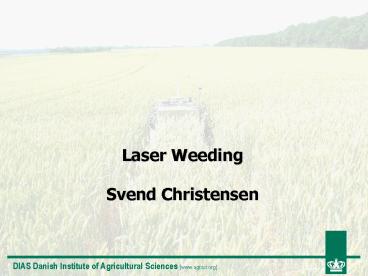Laser Weeding Svend Christensen - PowerPoint PPT Presentation
1 / 28
Title:
Laser Weeding Svend Christensen
Description:
Lasers concentrate energy in a thin beam and can be directed precisely and ... Triplerospermum inodorum (scentless mayweed) Brassica napus (rape) Exposure (ms) ... – PowerPoint PPT presentation
Number of Views:78
Avg rating:3.0/5.0
Title: Laser Weeding Svend Christensen
1
Laser WeedingSvend Christensen
DIAS Danish Institute of Agricultural Sciences
www.agrsci.org
2
Weeding Areas
Inter-row
Intra-row
3
Cutting weeds with a CO2 laser. T. Heisel, J.
Schou, S. Christensen, C. Andreasen 2001. Weed
Research 41, 19-30.
4
Why CO2 laser to cut weeds?
- Lasers concentrate energy in a thin beam and can
be directed precisely and quickly to cut weed
stems - Lasers do not till the soil and initiation of new
weed seed germination is thus not taking place - Dicotyledon weed species can be killed and
monocots can be reduced in size and delayed in
growth - CO2 laser is so far the most energy efficient
laser
5
- Circles pulsed IR light at 1064 nm from the
fundamental frequency of a Nd YAG laser - Triangles pulsed UV light at 355 nm from a
tripled Nd YAG laser - Squares continuous wave (CW) far-infrared light
(FIR) at 10.6 ?m from a CO2 laser
6
4 W 20 W
scissors
7
Conclusions Weed Research 41, 19-30
- The relationship between dry weight and laser
energy was successfully described using a
non-linear dose-response regression model - The regression parameters differed significantly
between the weed species - When stems were cut below the meristems, 0.9 and
2.3 J/mm of CO2 laser energy dose was sufficient
to reduce by 90 the biomass of C. album and S.
arvensis, respectively - Generally, no significant difference in biomass
reduction compared with plants cut by scissors
8
Using laser to measure stem thickness and cut
weed stems. T. Heisel, J. Schou, C. Andreasen, S.
Christensen 2002. Weed Research 42, 242-249.
- Investigate the influence of stem thickness on
the energy requirements to cut the stems of
Solanum nigrum and Beta vulgaris with a CO2 laser
9
Materials methods
- Solanum nigrum and Beta vulgaris
- Intensity
- 0, 1, 4, 10, or 20 W
- Speed
- 0, 1, 5 or 10 mm/s
- Thickness measurement of the plants at point of
cutting
10
Non-destructive thickness measure
Example
11
(No Transcript)
12
(No Transcript)
13
(No Transcript)
14
(No Transcript)
15
Dose-response model
- DOSE Intensity / speed (J/mm)
- Dose-response model
16
Black nightshade
17
Beet
18
Thickness stem/leaf vs. ED90
19
Conclusion Weed Research 42, 242-249.
- It was possible to use a laser to measure
thickness non-destructively - A laser-cutting tool for in-row weed control in
sugar beets is unlikely to be selective in
practice since results from B. vulgaris and S.
nigrum differ by growth stage - The non-linear model incorporating stem thickness
described the data best - indicating that it would be possible to optimise
laser cutting by measuring stem thickness before
cutting
20
The effect of laser irradiation of meristem on
plant growth. Solvejg K. Mathiassen Thomas Bak
Svend Christensen Per Kudsk. DIAS Flakkebjerg
Bygholm
21
(No Transcript)
22
Materials methods
- Laser/Spot size
- 1. 5 W, 532 nm, spot size 0.9 mm
- 2. 5 W, 532 nm, spot size 1.8 mm
- 3. 90 W, 810 nm, spot size 1.2 mm
- 4. 90 W, 810 nm, spot size 2.4 mm
- Species
- Stellaria media (common chickweed)
- Triplerospermum inodorum (scentless mayweed)
- Brassica napus (rape)
- Exposure (ms)
- 1.1 1.3 1.2 1.4
- 70 250 160
- 130 500 320
- 250 1000 640
- 500 2000 1260
- 1000 3000 2500
23
S. media treated with the 5 W, 532 nm laser.
(ms) 130 250 500
1000
(ms) 500 1000 2000 3000
S. media treated with the 90 W, 810 nm laser.
(ms) 130 250 500
1000
(ms) 320 640 1260
2500
24
T inodorum treated with the 5 W, 532 nm laser.
(ms) 130 250 500
1000
(ms) 500 1000 2000 3000
T inodorum treated with the 90 W, 810 nm laser.
(ms) 130 250 500
1000
(ms) 320 640 1260
2500
25
B. napus treated with the 5 W, 532 nm laser.
(ms) 250 500
1000
(ms) 1000 2000
3000
B. napus treated with the 90 W, 810 nm laser.
(ms) 250 500
1000
(ms) 640 1260
2500
26
DIAS Danish Institute of Agricultural Sciences
www.agrsci.org
27
Discussion - energy
- Approximately 150 J/mm is needed to cut one S.
nigrum stem with two-true leaves - If we consequently cut in all rows between all
beets leaving a guard of 2 mm on each side of the
beet, approximately 1970 mm/m2 have to be treated
corresponding to 2955 MJ/ha - If we can control the laser to cut only where
there are weed stems, there will be a potential
saving. Realistically we must include 2 mm
cutting on each side of the weed to account for
laser energy build up time and possible
inaccuracies. - With an overall density of 250 weed plants/m2 of
S. nigrum approximately 225 MJ/ha is required
28
Discussion
- The results of the experiment show that stem
thickness is an important co-variable that could
be integrated in a model based on the
dose-response model - Further research should include investigations of
the actual depth of the laser cut for various
levels of DOSE and plant material to - verify the energy calculations
- enable a test of the hypothesis that stem-shape
or morphological or anatomical characteristics do
not affect the effect of laser cutting

